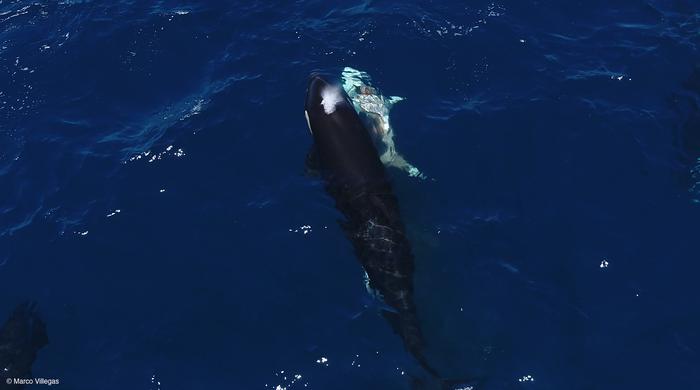On film, the sea abruptly assumes a surgical demeanor. In the Gulf of California, a closely-knit orca pod inverts young great white sharks, subsequently extracting the nutrient-rich liver with chilling exactitude. New findings from researchers in Mexico and the United States, published today in Frontiers in Marine Science, document two hunts that resulted in the death of three juvenile white sharks and highlight a specialized tactic, tonic immobility, that renders the prey paralyzed and vulnerable to dismemberment.
The scientists, spearheaded by Erick Higuera Rivas of Conexiones Terramar and Pelagic Life, recognized the perpetrators as Moctezuma’s pod, a group already well-known locally for pursuing rays and various sharks. In August 2020 and again in August 2022, five orcas rounded up juvenile white sharks, flipped them belly up at the surface, and resurfaced with pale liver lobes in their mouths. Birds gathered, tissues floated, and the remaining parts of each carcass were left behind. It is gruesome yet methodical.
The technique is significant. Flipping a shark upside down can induce tonic immobility, a temporary cataleptic state that disrupts a shark’s sensorimotor control. This strategy would neutralize the threat posed by even a small white shark’s bite, which can be sufficiently strong to harm an attacker. The team recorded consistent maneuvers across incidents, indicating learned, repeatable behavior within the pod.
A Pod With A Strategy
Moctezuma’s pod has a history. Earlier research in the area has shown the same group targeting Munk’s pygmy devil rays by selecting individuals from schools and stunning pelagic stingrays with tail slaps. Here, the orcas seem to apply a different approach to white sharks: invert, immobilize, extract, and then share. In one sequence from 2020, researchers captured on film two lobes of a shark liver being exchanged among at least three pod members, including females, while a curious sea lion was kept at bay through forceful bubble exhalations.
A striking detail emerges from the team’s videos and images. After a synchronized maneuver, a juvenile white shark ascends, bleeding from the gills, its mouth wide open, pectoral fins visible like banners. Moments later, a pink sheen of tissue rises as the orcas exchange bites. It appears to be predation executed with intent rather than mere opportunism.
“This temporary condition renders the shark defenseless, allowing the orcas to extract its nutrient-dense liver and likely consume other organs as well, before discarding the remainder of the carcass,” Higuera explained.
Importantly, the victims are juveniles, unlike the subadults and adults more typically linked to well-documented white shark abandonments when orcas are present. This distinction may hold ecological significance. Adult white sharks are known to vacate aggregation sites for months following encounters with orcas, a behavioral risk reaction that may limit predation success. In contrast, juveniles may not yet identify orcas as a definitive threat.
“Adult white sharks respond swiftly to hunting orcas by completely vacating their seasonal gathering spots and not returning for months.”
The authors caution that the two observed hunts do not establish a new precedent. However, they note that both incidents took place in the same general area in late summer, separated by two years, and involved a similar number of orcas employing nearly identical tactics. This pattern suggests seasonal targeting and social transmission of technique within the pod, aligning with what is known about orca cultures in other regions.
Climate Changes, Changing Targets
Why juveniles, and why in this location? The study highlights ocean warming and climate variability, including El Niño and marine heat waves, which are modifying nursery zones and redistributing cohorts of young white sharks along the eastern Pacific. Reports of juveniles in the Gulf of California have risen in recent years, potentially bringing unsuspecting sharks within range of resident or frequently visiting orcas.
There is also a metabolic rationale. Shark liver is abundant in lipids, serving as a compact source of calories and micronutrients that can be shared within a pod and, in various regions, appears to be the sought-after prize in similar orca predation on sharks. For a generalist predator equipped with culturally acquired tactics, a dependable seasonal supply of juvenile livers would be difficult to overlook.
Nonetheless, the researchers are cautious about drawing broad conclusions. They call for year-round surveys of the Gulf of California orca population, dietary analyses to confirm how often white sharks are preyed upon, and behavioral studies to assess whether juvenile white sharks develop the same rapid flight response seen in adults. Fieldwork is expensive, and the hunts are unpredictable, but the implications involve understanding how two apex predators navigate shifting seascapes and how climate-driven range alterations can modify predation dynamics.
For the moment, the scene is stark and unforgettable. Five black and white bodies, a flash of a crescent tail, a fleeting stillness as the world turns upside down.
